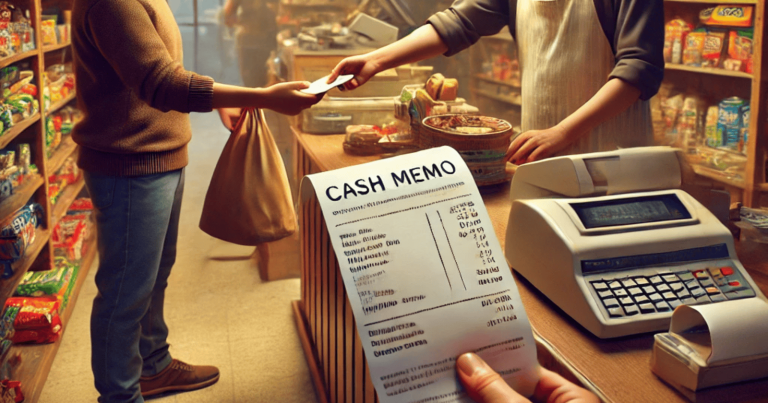When you buy something from a shop and pay the full amount, the seller gives you a small slip. This slip is called a cash memo. It is proof that you paid money and got your item. Every time you pay cash to a seller, they should give you this small paper. That paper helps you know how much you spent, what you bought, and from where. In simple words, a cash memo is a record for both the buyer and seller. It is important to know that a cash memo is different from a bill or invoice. A bill may be used when you buy on credit. But if you pay full cash at the time of buying, then the seller gives you a cash memo. This is common in grocery stores, cloth shops, mobile stores, and even restaurants.
What is a Cash Memo?
A cash memo is a document that a seller gives to a buyer when they pay in full using cash. It proves the purchase and payment happened. It also helps both the buyer and seller keep a record.
Shops use it daily. The memo shows the name of the items, quantity, price, and the final total. It also has the date and name of the shop. It is used when a person pays the total amount during the purchase. You do not get this memo when you pay later or buy on credit.
Why is it important?
It helps track expenses. You know how much money you spent and what you bought. If there is a problem later, you can use this memo to return the product or get a refund.
Who uses it?
- Grocery stores
- Cloth shops
- Bookstores
- Mobile shops
- Restaurant counters
- Local traders
Every seller who takes full payment at the time of sale can give a cash memo.
Why is a Cash Memo Important?
Many people ignore this small piece of paper, but it plays a big role. The importance of cash memo in business and personal spending is very high.
It helps in tracking daily spending: Buyers often forget what they spent. A cash memo helps keep a record. Later, you can match it with your budget. Even small expenses can be tracked this way.
It protects the buyer: If something goes wrong with the product, this memo helps get a refund or replacement. Sellers may ask for it before accepting returns.
It helps the seller too: Sellers keep one copy of the memo with them. That helps track how much money they earned daily. It becomes part of their accounting and tax records.
It helps in business accounting: Small business owners can use these memos to:
- Know daily sales
- Create reports
- Pay proper taxes
- Manage stock and goods
Format of a Cash Memo
The format of a cash memo is simple but must include some key things. Whether it is handwritten or computer-generated, every cash memo must have:
| Field | Description |
| Shop Name | Name of the seller/shop issuing the memo |
| Address & Contact | Location and contact details of the shop |
| Date | When the transaction happened |
| Memo Number | Unique number for tracking |
| Buyer Name | (Optional, mostly left blank in small sales) |
| List of Items | Name, quantity, and price of each item sold |
| Total Amount | The total value paid in cash |
| Taxes (if any) | GST or any applicable tax |
| Payment Mode | Mention ‘Cash’ clearly |
| Signature | Seller’s stamp or sign |
Cash Memo vs Invoice vs Bill
Many people confuse cash memo, bill, and invoice. But they are not the same , their use in business is very different from one another. Cash memos are strictly used for cash payments whereas invoices are generated for credit transactions. Bill is another type of invoice but used for both cash and credit transactions.
Cash Memo
- Used when full payment is made at the time of purchase
- Only used for cash payments
- Mostly used by shops, restaurants, and local vendors
Invoice
- Given before payment
- Used when payment is due later (credit sales)
- Common in business-to-business (B2B) deals
Bill
- Similar to invoice but may be used for both cash and credit
- Used in restaurants and hotels
So, when someone pays in full using cash, the seller issues a cash memo only.
Users of Cash Memo
You can use a cash memo whenever a sale happens with full cash payment. Here are some real-life cases:
- Small Shop Owners: They give this to customers for grocery, fruits, or household goods. This helps them manage daily sales.
- Restaurants: Restaurants give a memo at the cash counter once you pay the full bill amount. It works like a bill but acts as a cash memo.
- Freelancers or Tutors: If a student pays full fees in cash, tutors can use a simple cash memo to confirm payment.
- Students in School Projects: Sometimes school students are asked to submit expense proofs. They can use cash memos from stationery shops to show what they bought.
Benefits of Cash Memo for Small Business
Small business owners gain many benefits when they use cash memos regularly. It helps them grow and manage things better.
- Record-Keeping: Cash memos keep daily records. This helps during audits or when checking how much sales happened in one day.
- Avoiding Disputes: If a customer claims something is wrong, the memo can act as proof of sale. It shows what was bought and when.
- Easy Tax Filing: If the business is registered under GST or other taxes, they can use memos to show their total sales.
- Stock Control: When they sell something and issue a cash memo, they know the stock has gone down. So, it becomes easier to know when to order new goods.
- Legal Proof: It can act as proof in case of legal or consumer-related disputes.
How to Store and Manage Cash Memos?
Keeping all cash memos safe is very important, especially for shops, as cash memos serve as evidence and also helps in fulfilling regulatory requirements. They can be stored and managed in following manner:
- Use File Folders: If the memos are handwritten, keep them in dated folders.
- Use Excel or Digital Tools: You can note down memo numbers and totals in Excel. This helps in finding them easily.
- Apps for Memos: Apps like Vyapar, Zoho Invoice, or Invoice Maker help small business owners create and manage cash memos digitally.
Relevance to ACCA Syllabus
Cash memos play a foundational role in recording revenue transactions, an essential concept within Financial Accounting (FA) and Management Accounting (MA) papers. ACCA expects students to understand source documents like cash memos for proper bookkeeping, revenue recognition, and audit trail purposes.
Cash Memo ACCA Questions
Q1: What is the primary purpose of a cash memo in accounting?
A) To record credit transactions
B) To record receipt of payments for services
C) To serve as a source document for cash sales
D) To document accrued revenue
Ans: C) To serve as a source document for cash sales
Q2: Who typically issues a cash memo?
A) Buyer
B) Auditor
C) Seller
D) Accountant
Ans: C) Seller
Q3: Where is the cash memo recorded in the books of accounts?
A) Purchase Book
B) Cash Book
C) Sales Book
D) Journal Proper
Ans: B) Cash Book
Q4: What kind of transaction does a cash memo indicate?
A) Future payment expected
B) Barter transaction
C) Immediate cash sale
D) Service rendered on credit
Ans: C) Immediate cash sale
Q5: Which accounting principle is most associated with the use of cash memos?
A) Matching Principle
B) Revenue Recognition Principle
C) Accrual Principle
D) Prudence Principle
Ans: B) Revenue Recognition Principle
Relevance to US CMA Syllabus
Cash memos relate directly to internal control and transaction processing systems, topics covered in Part 1: Financial Planning, Performance, and Analytics of CMA. Understanding source documents like cash memos helps in controlling revenue flows and evaluating operational efficiency.
Cash Memo US CMA Questions
Q1: A cash memo would be most useful in which business scenario?
A) Purchase of assets on credit
B) Cash sale at point-of-sale terminal
C) Loan repayment entry
D) Monthly payroll accounting
Ans: B) Cash sale at point-of-sale terminal
Q2: Which system is most likely to generate a cash memo automatically?
A) Manual ledger system
B) Enterprise Resource Planning (ERP) system
C) Fixed Asset Management system
D) Payroll software
Ans: B) Enterprise Resource Planning (ERP) system
Relevance to US CPA Syllabus
Cash memos are covered under Auditing & Attestation (AUD) and Financial Accounting & Reporting (FAR) in CPA as they help in substantive testing of sales transactions and ensuring documentation trails for audits.
Cash Memo US CPA Questions
Q1: Which internal control is supported by the issuance of a cash memo?
A) Physical inventory count
B) Authorization of payroll
C) Recording of cash sales
D) Bank reconciliation
Ans: C) Recording of cash sales
Q2: An auditor finds inconsistencies in cash sales. Which document will help verify these transactions?
A) Sales Invoice
B) Credit Note
C) Purchase Order
D) Cash Memo
Ans: D) Cash Memo
Relevance to CFA Syllabus
While CFA focuses more on financial statement analysis, understanding the flow of original entries from documents like cash memos helps in evaluating revenue trends, especially under Financial Reporting & Analysis (FRA).
Cash Memo CFA Questions
Q1: How do cash memos indirectly influence financial statement analysis?
A) They determine capital structure
B) They contribute to cash sales entries in the income statement
C) They are used for calculating depreciation
D) They record long-term investments
Ans: B) They contribute to cash sales entries in the income statement
Q2: In the context of financial reporting, cash memo details contribute to: A) Cost of Goods Sold (COGS)
B) Operating Cash Flow
C) Financing Activities
D) Long-Term Liabilities
Ans: B) Operating Cash Flow


